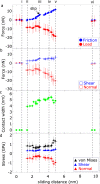Ultrahigh strength and shear-assisted separation of sliding nanocontacts studied in situ
- PMID: 35538085
- PMCID: PMC9091249
- DOI: 10.1038/s41467-022-30290-y
Ultrahigh strength and shear-assisted separation of sliding nanocontacts studied in situ
Abstract
The behavior of materials in sliding contact is challenging to determine since the interface is normally hidden from view. Using a custom microfabricated device, we conduct in situ, ultrahigh vacuum transmission electron microscope measurements of crystalline silver nanocontacts under combined tension and shear, permitting simultaneous observation of contact forces and contact width. While silver classically exhibits substantial sliding-induced plastic junction growth, the nanocontacts exhibit only limited plastic deformation despite high applied stresses. This difference arises from the nanocontacts' high strength, as we find the von Mises stresses at yield points approach the ideal strength of silver. We attribute this to the nanocontacts' nearly defect-free nature and small size. The contacts also separate unstably, with pull-off forces well below classical predictions for rupture under pure tension. This strongly indicates that shearing reduces nanoscale pull-off forces, predicted theoretically at the continuum level, but not directly observed before.
© 2022. The Author(s).
Conflict of interest statement
The authors declare no competing interests.
Figures





Similar articles
-
Covalent Bonding and Atomic-Level Plasticity Increase Adhesion in Silicon-Diamond Nanocontacts.ACS Appl Mater Interfaces. 2019 Oct 30;11(43):40734-40748. doi: 10.1021/acsami.9b08695. Epub 2019 Oct 16. ACS Appl Mater Interfaces. 2019. PMID: 31498997
-
Quantitative measurement of contact area and electron transport across platinum nanocontacts for scanning probe microscopy and electrical nanodevices.Nanotechnology. 2019 Nov 27;30(4):045705. doi: 10.1088/1361-6528/aaebd6. Epub 2018 Nov 27. Nanotechnology. 2019. PMID: 30479311
-
Deformation Behavior and Critical Shear Stress of Copper Nanocontacts Studied by In Situ Transmission Electron Microscopy.J Nanosci Nanotechnol. 2018 Jan 1;18(1):90-94. doi: 10.1166/jnn.2018.14571. J Nanosci Nanotechnol. 2018. PMID: 29768817
-
A new view of the onset of plasticity during the nanoindentation of aluminium.Nat Mater. 2006 Sep;5(9):697-702. doi: 10.1038/nmat1714. Epub 2006 Aug 13. Nat Mater. 2006. PMID: 16906139
-
Sliding History-Dependent Adhesion of Nanoscale Silicon Contacts Revealed by in Situ Transmission Electron Microscopy.Langmuir. 2019 Dec 3;35(48):15628-15638. doi: 10.1021/acs.langmuir.9b02029. Epub 2019 Aug 22. Langmuir. 2019. PMID: 31397572
References
-
- Sawyer WG, Wahl KJ. Accessing inaccessible interfaces: In situ approaches to materials tribology. MRS Bull. 2008;33:1145–1150. doi: 10.1557/mrs2008.244. - DOI
-
- Jacobs TDB, Greiner C, Wahl KJ, Carpick RW. Insights into tribology from in situ nanoscale experiments. MRS Bull. 2019;44:478–486. doi: 10.1557/mrs.2019.122. - DOI
-
- Pereira ZS, da Silva EZ. Cold welding of gold and silver nanowires: A molecular dynamic study. J. Phys. Chem. C. 2011;115:22870–22876. doi: 10.1021/jp207842v. - DOI
-
- Szlufarska I, Chandross M, Carpick RW. Recent advances in single-asperity nanotribology. J. Phys. D: Appl. Phys. 2008;41:123001/1–12300139. doi: 10.1088/0022-3727/41/12/123001. - DOI
Grants and funding
LinkOut - more resources
Full Text Sources

